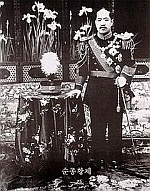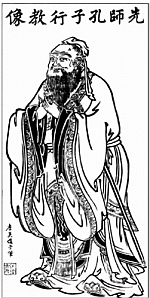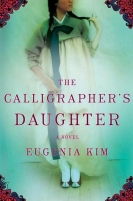HISTORICAL
FICTION
|
|

|
|

General
power of attorney to Lee Wan-Yong signed and sealed by the last
emperor, Sunjong of Korean Empire upon compulsion. Traditionally, the
Korean monarch did not sign official documents with his name. In the
situation which Japan held hegomony in Korea, the Korean Emperor was
forced to follow new Japanese customs.
|

Sunjong
Emperor of Korea (1907-1910)
|

Engraving of
Confucius
|
|
BOOK
ILLUMINATIONS
From Merrimon Book Reviews
HOME
ROMANCE
FICTION SUSPENSE & THRILLERS
MYSTERY
AUTHORS REVIEWER
PROFILES
|
The Calligrapher's Daughter

by Eugenia Kim

Moving
narrative of artistic restraint
The Japanese occupation
looms over Korea at the beginning of Najin Han's life. Although
born into an aristocratic yangban family, Najin's life is marked by
this turning point of history transforming her life from her father's
unwillingness to name his daughter. Najin's father, a respected
calligrapher and artist, protests against the changes in Korean society
and the slow deterioration of the unique Korean identity and
traditions. Raised in a family influenced both by Confucian and
Christian faiths, Najin struggles to find her own identity amid the
pressures within her family and world events over which she has little
control. When her father tries to marry her into an aristocratic
family, her mother defies tradition and sends her to the king's
court. From this moment on, Najin's life takes a turn as hopes
within her motivate her and the increasing oppression in the wake of
Japan's growing presence limit her ability to follow her
dreams. Torn between ancient traditions and a modern desire to
forge a new direction, Najin's life exemplifies patience and faith as
she faces the specific challenges of her historical time.
Eugenia Kim's debut novel THE
CALLIGRAPHER'S DAUGHTER gives readers a glimpse into a lesser
known period of Korean history through the voice of a fictional
woman. Spanning the years 1915 to 1945, Najin's life story looks
at a turbulent time of political and financial unrest and change
through the lens of the Han family. As the monarchy fades and the
the depression hits, centuries of culture and tradition disappear, not
only from political measures but also by the changing pressures as the
aristocracy's dominance gives way to a rising, economic need.
Against this historical backdrop, Eugenia Kim tells the story of a
woman born into a traditional family but also a woman determined to
realize her dreams. Despite the difficulties that her father's
goals present to her, Najin has a certain generosity of spirit in the
ways in which she describes her family. The relationship to her
father and her growth in understanding his values present some of
the most poignant moments of the narrative, particularly as she
describes her father's art.
The straightforward narrative style of THE CALLIGRAPHER'S DAUGHTER adds a
subtle beauty to this novel. On the surface, the novel relates
the events without the intensity or tension-filled emotion a reader
might expect given the historical setting. As the book unfolds,
however, the beauty of this novel lies in the restraint. Although
the narrator Najin does not hide the atrocities of the Japanese
occupation, neither does she subordinate the narrative to a political
diatribe. Indeed, some of the images achieve their power
precisely because they emerge through the process of the narrative and
the reader's imagination rather than the author overdramatizing those
moments. At times the sadness of a whole world in transition can
be evoked in the image of the father's changing relationship to his
art. Najin's and her mother's Christian faith form an integral
part of the story and yet, so does doubt. THE CALLIGRAPHER'S DAUGHTER is not
a simplistic novel of faith inspiring a person during the worst of
times nor does it use Confucianism as a simplistic opposition to
Christianity. The story of Najin's marriage also develops over
time as Najin's immediate world changes, allowing the reader to feel
the inner force of Najin's character. Eugenia Kim tells her story
from inside out as Najin's feelings and steadfastness take prominence
over actual individual events. At first glance, the initial pacing of the story
might seem slow to some readers, particularly in contrast to dramatic
works of fiction, but herein lies the power of THE CALLIGRAPHER'S DAUGHTER.
The emotions evoked emerge all the more powerfully for the author's
ability to incorporate artistic restraint and sparseness within the
narrative, allowing the images to speak for themselves. THE CALLIGRAPHER'S DAUGHTER is the
kind of novel that almost sneaks up on a reader with its beauty, but
that beauty is most striking and memorable.
Publisher: Henry
Holt (August 2009)
Reviewed by Merrimon,
Merrimon Book Reviews
Review Courtesy of Amazon Vine

|
|
|